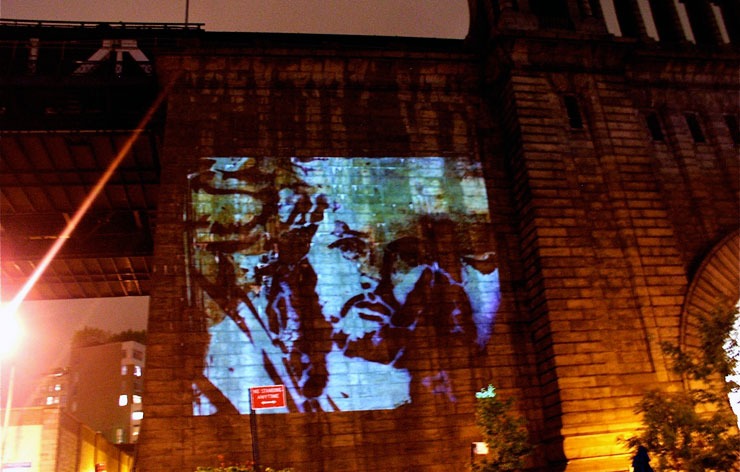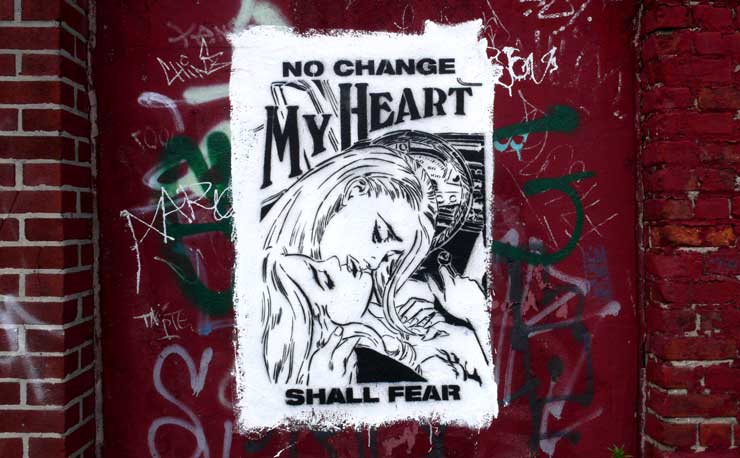To the uninitiated, the messages and images purveyed in the ever-changing street art scene can strike you as mysterious, disjointed or wholly unrelated to current discourse even as they seem to hint at it's subtext. As street art watchers we are surprised every week by something unexpected and sometimes we pour over new pieces for their meaning. During the GLBT Pride month of June we began seeing new pieces on the street by the Brooklyn street art duo Faile that touch on themes not typically addressed in street art, namely, lesbians and transgendered people. Part of a series of new stencils by the pop and pulp art inspired language of Faile, the pieces appearance and their length of endurance running on the street may indicate a more generational shift in the street art culture as it continues forward. Typically, if a message is untenable, you'll expect it to be "crossed out," "tagged over," or "buffed" by others pretty quickly, as the ongoing conversation on walls is rapid and fluid. These images have been undisturbed on the street and fairly unremarked, even by fans and followers who distribute the images on Flickr. As one of the first collectives in this current Street Art era, Faile have frequented the social and political spheres with their stenciled messages over the last decade and to them, it's just one more topic they are glad to address.
BSA had the opportunity to ask Faile about these new pieces and their significance to the artists.
BSA: You still see and hear words like "faggot" and "homo" thrown around in graff and street art community occasionally. How would you describe the attitudes you see in the street art culture, and before that, graffiti culture, toward people in the GLBT community?Faile: I don't think we're around this that often. At least not among the people we hang with. These words are thrown around casually by some, unfortunately, though this is not specific to street art. Either way, this isn't a place we really dwell. We're a little more lone wolf than pack hunters, on the street anyway.
BSA: What drew you to the topic of equality for gay, lesbian, bisexual, or transgendered people?Faile: We didn't specifically set out to make work about this topic. Many times, and especially recently, our image-making process is loose and experimental. We've been having fun with that again, really just playing. As some of the new images have come together we found something very provocative about an image of two girls locked in a passionate kiss. It was only later that in passing the image back and forth we placed this type from an old church pamphlet I found in my Grandma's house. "No change my heart shall fear" seemed to speak so honestly, when paired with this image, to this crossroad in our culture. Where there is a group of people that are unfairly singled out and not given the same rights, especially with regard to marriage equality. It was this change that we spoke to, though in the image's openness it can be interpreted in many ways.
The image-making is like this at times. You'll create an image or collage something and it will just sit like that for some time. At times, it doesn't need anything more and it's better left open-ended and other times it really helps complete the idea; coming alive when there is type or a message paired to it.
The Gender Bender image of the "girl" at the urinal was again coming from a place of rawness and just the fun of making imagery. Sometimes it's not until later that these have a power once they are out in the world, independent of our intentions. The work really invites the viewer in this way to bring their own interpretation to what's there. The Bunny Boy image is a great example of that, it's enticing and visceral in its mystery. Images speak to people in a variety ways.
BSA: From a broader perspective, what role do you think Street Art can or should play to affect social or political change?Faile: It's a form of communication for the people. Meaning it's direct and aims straight to the masses. In it's most sincere form it's there for anyone and not wrapped up in a hidden agenda. In this way, it has great power and people respond to that. I think it has saturation points and has been co-opted by some along the way, but I also believe there is a huge energy there and when struck in the right way can move mountains.

BSA: Punk posters in the 70's and 80's used assemblage of text and images to create messages that struck at the heart of a system people considered hypocritical or sick. How much of your work feels like punk to you today?Faile: Our process has always resembled this loose and fast critique on society, whether it be literal or figurative. Our image-making has at times been very methodical and researched, other times it's been experimental and dirty. Street art at its roots is "punk." It set out to critique and comment on a world it felt outside of. I don't know if it's for us to decide really. We are just doing what feels right to us. If people see this as that, then so be it.
A version of this post originally appeared at BrooklynStreetArt.com.


